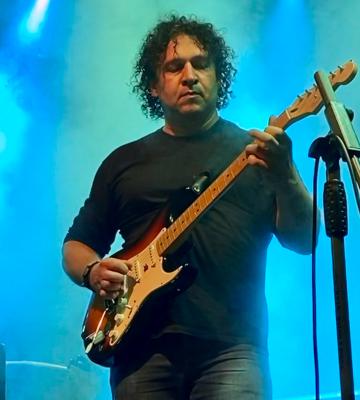now playing:
More
- Legato Workshop 3LEVEL 5Legato technique using open strings.
- Modes Workshop 4 - Modes Over ChordsLEVEL 2Simple but effective etude for practicing different modal voicings over corresponding chords.
- Legato Workshop 1LEVEL 7This is the part 1 of the workshop based on Legato technique for beginners & intermediate players.
- Legato Workshop 2LEVEL 7Work on your timing and soft picking.
- Applying Modes - Part 1LEVEL 5Learn to apply modes to the most common progressions.
- Applying Modes - Part 2LEVEL 5Learn to apply modes to the most common progressions.
- Chord Workshop #3 - PowerchordsLEVEL 3In this part of the workshop series we will learn what power chords are, and play them on the neck within the diatonic scale to get familiar with the shapes and positions.
- Improvising Workshop - Level 3LEVEL 4Course designed to help you understand and boost up your improvising skills. From a complete beginner to advanced concepts - a valuable tool for every musician. This is lesson number 3 where we work on a very important progression for modern music: I-IV-V.
- Arpeggio WorkshopLEVEL 3Get into 7th chord arpeggios by using vertical 7th chord arpeggio patterns
Feedback
 Daniel Realpe30th April 2010
Daniel Realpe30th April 2010great job on this lesson!
 Dejan Farkas25th October 2008
Dejan Farkas25th October 2008Well done Ivan, nice work

 Ivan Milenkovic24th October 2008
Ivan Milenkovic24th October 2008Thanks guys

@ Gerardo
Thanks for the idea
 Hisham Al-Sanea23rd October 2008
Hisham Al-Sanea23rd October 2008good job Ivan.
 Gerardo Siere23rd October 2008
Gerardo Siere23rd October 2008Great lesson, excelently explained, I would add anc accent every four notes, some time we want the accent in the picked noto and some times not.
 Bogdan Radovic23rd October 2008
Bogdan Radovic23rd October 2008Excellent lesson Ivan!!

 Ivan Milenkovic23rd October 2008
Ivan Milenkovic23rd October 2008Thanks a lot guys, I appreciate it

Alex8723rd October 2008
Great lesson Ivan, good series

 Piotr Kaczor23rd October 2008
Piotr Kaczor23rd October 2008Excellent quality, very useful lesson Ivan!!
 Jose Mena23rd October 2008
Jose Mena23rd October 2008Nice Ivan, I liked the way you demonstrate the same lick using different note durations, very helpful timing exercise, good work
 Nazgul23rd October 2008
Nazgul23rd October 2008Very good work, Ivan! Keep up the work!

 kaznie_NL23rd October 2008
kaznie_NL23rd October 2008Thanks Ivan! Keep up the good work Ivan1!
 Emir Hot23rd October 2008
Emir Hot23rd October 2008you are doing very good job with this series, very nice idea
 Muris Varajic23rd October 2008
Muris Varajic23rd October 2008Well done lesson,nice explained.

 Ivan Milenkovic23rd October 2008
Ivan Milenkovic23rd October 2008Thanks guys

 SensE23rd October 2008
SensE23rd October 2008Good exercise. Thank you, Ivan
 Lian Gerbino23rd October 2008
Lian Gerbino23rd October 2008well done Ivan, this series is great!
 Pedja Simovic23rd October 2008
Pedja Simovic23rd October 2008Good job Ivan !
Moon Boots23rd October 2008
Great - looks really in depth!
- Lesson
- My notes
Hey GMC, and welcome to my third in a line of lesson about modes, from the series "Modes Workshop".
In this lesson we will go further with our three "note per string"-pattern that we learned in previous lessons. The purpose of this lesson is also to embed the patterns firmly in out memory, and beside that we also have 2 main objectives:
1. Learning legato technique - In this lesson we are using hammer-ons and pull-offs to fret the patterns. This way we are covering a broader range of techniques, so that we'll have a good foundation for further advancing, besides alternate and economy picking from the 2 previous lessons.
2. Finding new root (mode) on the pattern - As you may remember, in the previous 2 lessons we used roots on low E and A strings. Now we again use root on A string, but this time it is a different note. Why this note you may ask? Well because this note makes a chordal shape within the pattern that is one of the three basic open chords.
For now you don't have to remember all of the said above about chords, and just practice the shapes with legato and memorize the roots. In the next lesson we will cover some basic exercises on how to actually use what we've learned so far in every day situation examples. So practice this a bit and stay tuned for next lessons.
You can use the backings as well for this lesson. Each backing is set t0 60bpm just like the metronome in the videos, and one chord strumming over the drum pattern. The chord relates to every video, so you can practice with a rhythm guitar as well.
This lesson contains:
- legato technique
- modes workouts
- three note per string patterns
From this course:
- Modes Workshop Part 1 - Alternate PickingLEVEL 4Contains scales using three note per string patterns that every player should know.
- Modes Workshop Part 2 - Economy PickingLEVEL 3Contains three notes per string patterns useful for remembering the modes systematically. In this lesson we are focusing on economy picking and A string notes to find different sets of modes on the same positions.
- Modes Workshop 4 - Modes Over ChordsLEVEL 2Simple but effective etude for practicing different modal voicings over corresponding chords.
Jump to start: Home or `s` , you can also click/tap the lesson part again (the numbers above player)
Go to next part: PageUP or End.
Volume: ArrowUp / ArrowDown keys
Go to any part: Number keys (combinations also possible)
Pause or play: `k` or space key
Fullscreen: `f`, esc to close
Increase / decrease speed : `+` or `-`







